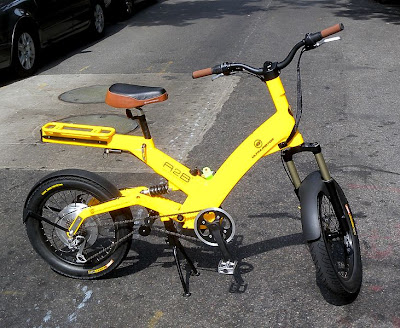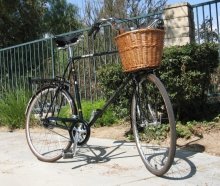No one has done more to promote electric bicycles than Ed Benjamin. As many of my readers know, I am an enthusiastic supporter of this technology, so I wanted to introduce the subject through the eyes of the world's leading expert. Mr. Benjamin was kind enough to agree to an interview. Enjoy.
Q: Many of my readers are "bicycle purists." What would you like to say to them about electric bicycles?
A: I am going to consider a “bicycle purist” as a person who believes and asserts that only human power should be used to propel a manual bicycle.
I used to feel that way and let me present my credentials as a purist: I worked in, or owned, bicycle shops from 1969 to 1996. I was a Jr. State Champion, Bicycle Road Racing, and later an ABLA Senior “B” racer (for those too young to know, ABLA preceded USCF and a Category B was equivalent to a Cat 2 today). I am an ex USCF Cat 2 official, and have promoted bike races, triathlons, and club events too numerous to remember. I was riding a “fixie” back when we called them track bikes. My current manual bike is a Moulton.
People like me often own bike shops and are often “purists.” And it is common for me to hear “I don’t need no stinking motor” along with comments about lazy, or cheating, from my peers.
But this attitude and definition of bicycle purism is one that I associate with “bicycles as sport”. For the USA and parts of Europe, that is the primary use of a bicycle, riding for fun, competition or fitness.
Ultra Motors A2B Electric Bicycle
But world wide, the billions of people whom ride a bike every day, do so for transportation.
“Bicycle as transportation” is a different matter, and the sport rider may not have considered that strong legs, a good wind and the time and interest to ride are luxuries to most transportation riders. Transportation riders are not much interested in sweating, being tired from their commute, or improving their fitness.
For a transportation rider, a bicycle is an upgrade from walking and an electric bike is an upgrade from pedaling a manual bike. An electric bike allows one to get to work without dripping sweat and it allows one to go farther with less effort – often translating into a better job or a nicer home (being located farther out, and thus costing less). In some cases, an electric bike is a vehicle that can cut through the traffic jam, or find a parking place.
Transportation riders, even in the USA, include the old, the fat, the pregnant, the injured, the less than fit, and others for whom a bicycle is a tool that enables them. The bicycle is not recreation, fitness, sport, or a lifestyle.
So, purists…I say that you are fortunate to live with a luxury that you may not appreciate. And…it is not forever. Your strong legs and good wind will give way, no matter how hard you work at it.
And as evidence of the role that an electric bike may play in your future, consider the electric bike riders of Holland, Germany and Switzerland. These are strong bicycle cultures where one’s fitness and strength are matters of great pride and concern. And places where the average age is rising fast. These older riders, who, on the average, have far more miles behind them than any USA “purist”, have found that the electric bike allows them to be comfortable on their bikes, at an age when they were finding the manual bike to be increasingly arduous.
And many westerners do not realize how strong a “bicycle culture” exists in China and other Asian countries. Although their bike culture is riding a 60 lb roadster everywhere, for decades, and living and working up many flights of stairs. Bicycles are a major transportation tool in China, SE Asia, India, Africa, and many other places. These are fundamentally bike cultures in ways that most westerners do not appreciate.
The USA will buy every year, around 15 million bikes. A lot of them are children’s bikes. The EU is similar, but with a larger proportion of adult bikes. And China is about 56 million bikes, almost all for adults.
Approximately 1 in 2 bikes sold in China is electric. About 1 in 4 in Holland. 1 in 8 in Germany, 1 in 10 in Switzerland.
Wavecrest Laboratories TidalForce Electric Bicycle
Q: What are the best things about electric bicycles?
A: They extend the rider’s range, reduce his fatigue, are generally more comfortable and have more functional utility for the transportation rider.
They are green. Yes, really. An interesting study from Germany shows that an electric bike actually produces less carbon in its life than a manual bike – even if the rider of the manual bike eats only vegetables. Of course, the manual bike user also benefits from increased fitness, a worthy benefit that may outweigh the carbon they are creating. Anyone who emails me and asks for it can receive a copy of the study (ed@eCycleElectric.com).
Nearly everyone who rides one for the first time gets a big grin. They are fun (the last time I saw these grins was in the early 80’s when customers test rode the new fangled ‘mountain bikes’).
They make money for all parts of the bike industry. They are a higher ticket, higher margin, and more attractive to a wider demographic than manual bikes.
They are affordable and improve the life of many millions of people (there are an estimated 119 million in use today).
Q: Please describe the "typical" electric bicycle rider.
A: I will present four:
Hong J. is a 46-year-old schoolteacher in Shanghai whose ebike allows her to live farther from the metro station. That allowed her to buy a much nicer home. And she gets to work less tired and cleaner than riding her old manual bike. It is easy to carry her son, or groceries or both. Her transportation costs for the year are equal to one month of wages (most Americans will work for many months to pay for their annual transportation costs).
Hans O. is a 67-year-old retiree living in the Appledorn, Holland. His ebike allows him to accompany his wife on rides to cafes that were becoming just a bit too far to reach on his manual bike on Saturday mornings. (Anyone see the historical reference?)
Jim S. is a 29 year old in Los Angeles who is personally committed to reducing his carbon footprint. He is adamant about using his ebike and mass transit to get to work and to run his errands. He does not regard himself as a cyclist. His choices are not convenient, but a matter of principle.
Lee P. is a retiree living in Orlando, Florida. He and his wife ride their electric bikes no farther than a few blocks. They appreciate the comfortable saddles as they sit on the bikes for hours talking to their friends and neighbors about … their bikes.
Q: What are LEVA's primary goals?
A: To promote the use and business of electric powered two wheelers and other light electric vehicles. We are primarily an industry group, and we help with networking, information, and services.
Q: What needs to happen - culturally, economically, politically, etc. - in order for the electric bicycle to become a viable alternative to the automobile in American society?
A: Exactly what is happening today:
- Fuel price is rising (120 per barrel as I write)
- Americans are less affluent than before, and we are undergoing changes in lifestyle – and the necessary change in transportation costs is a biggie.
- Americans are moving more and more to the city. In the city, a manual or electric bicycle is more useful than in a suburban or rural setting.
- Traffic congestion.
- Shortage of parking spaces in cities.
- Politicians and planners looking for ways to reduce costs and improve lives.
Electric Bicycles in Suzhou, China - Photo by Patrick Benjamin, 2009
Q: Why has the electric bicycle been such a huge success in China?
A: It works for the dense coastal cities where traffic congestion, parking shortage and air pollution are important issues. And where the majority of Chinese live.
Most Chinese are cyclists already. The ebike is a step up for them. But even Chinese car owners often have an ebike as well – finding a parking place for the car is often impossible. And the traffic jams can be a major problem.
Strong government encouragement, in terms of licensing costs, bans on gasoline motorcycles, bans on mopeds, etc.
Cheap to buy, cheap to maintain, and very low cost for fuel.
Q: Electric bicycle sales in Europe have also been growing rapidly, although not to the same extent as they have been growing in China. Do you see this trend continuing? Or will ebike sales in Europe plateau?
A: I believe that ebikes will become about 1 in 2 bikes sold in Europe. A combination of the same reasons I list above for USA, plus a rapidly aging population and a strong two-wheel culture.
Q: What electric bicycle(s) do you ride? What do you like about it/them?
A: I have an old Tidal Force bike that I love because it is fast, solid and a product of my work. I also have a Trek ebike that is a pedelec that uses BionX motor – both companies that have been my customers. Keep in mind that both bikes were free. There are a LOT of good bikes available today.
Q: How do you see electric bicycle design developing over the next 5 to 10 years?
A: World wide, I believe the trend will be towards a light scooter concept, something like a Yamaha Passol. In the USA and EU I expect it to be more like the popular pedelecs of Germany and Holland.
The Yamaha Passol
Q: What else would you like to say?
A: Bicycles are a bit like the typewriter. There was a time when a manual typewriter was the standard. It was replaced by an electric typewriter, and later by a computer. We are sort of where the electric type writer came in, and it is just as hard for us to know what the evolution of the ebike will be – as it would have been for an electric typewriter engineer or user to imagine the laptop I am writing this piece on.
Electric two wheelers face a bright, and interesting future.
Thanks for the venue.
Q: What do you like for breakfast?
A: Fried eggs (with soy sauce, due to many breakfasts eaten in Asia) a strip of bacon, fruit. Coffee and OJ.
And if I am not riding a bike, I drive a pickup. Like the farmers I am descended from. But, at 80.00 to fill the tank…I avoid using it.








